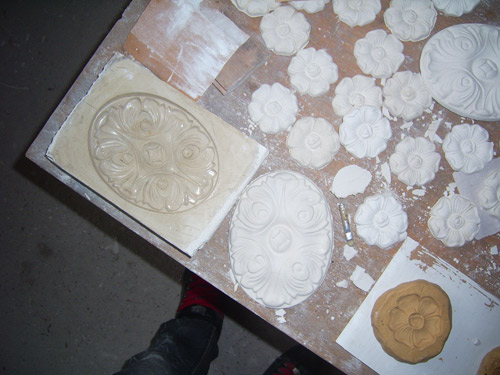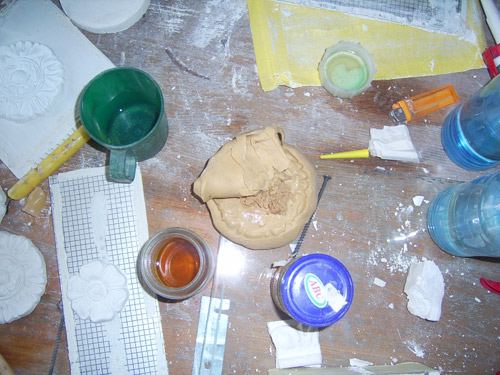Manual molding made of gypsum - a volumetric relief decoration used for exterior or interior decoration premises. It can help you:
- structure space;
- hide some or other disadvantages architecture;
- arrange the necessary accents in the interior, etc.
Content
The use of decorative products from plaster will give each room a most respectable and noble appearance.
Product features of modeling:
- utilitarian (able to hide a variety of structural elements);
- aesthetic (help translate any design imagination).
Elements of decorative products from plaster:
- plinth;
- moldings;
- cornices;
- ceiling sockets;
- brackets;
- pedestals;
- pilasters;
- pilasters;
- column.
Luxury decorative elements, which are made of high-strength gypsum, able to guarantee exceptional quality, perfect precision of the connection, the observance of all sizes and easy installation at the professional approach.
Advantages of stucco plaster:
- environmental friendliness;
- blamelessness;
- fire safety;
- durability;
- easily restored;
- is a classic;
- resistant to temperature changes;
- Gilding, painting and different processing;
- Allows you to hide many architectural errors and implement any idea.
Today, the extraordinary beauty of the plaster stucco is available to everyone. Multiple decorative elements are able to make a new life in the interior details, thereby giving them a special charm, as well as create a feeling of stability, brightness, reliability and ease.
The only competitor of plaster stucco is considered to be stucco from polyurethane, which is most practical in some respect.
Gypsum - unique material, organically combined with other products of natural origin: glass, metal, wood, ceramics and stone. In this case, the plaster stucco is capable of absorbing excess moisture and evaporate it with a decrease in air humidity. Its main advantage is the possibility of creating decorative elements by individual order.
Today, stucco from plaster on the walls and the ceiling is produced in a wide variety of directions - ranging from Baroque and ending with a classic or even ultra-modern style.
How to make a stucco of gypsum
Gypsum - fragile and capricious material, however, it was precisely experts for the manufacture of stucco. This building material was characterized by such a property as an extension, which allows it to penetrate the smallest embossed shapes and cracks, ensuring high accuracy of the product performed. When creating a fill of gypsum forms, it is necessary to make a slight shaking, which ensures the elimination of air bubbles and thoroughly filling in a small structure.
To reduce the charge, the gypsum is bred on lime water, applying for its preparation haired and forgery. For a solution that will be used for casting, water and gypsum is taken in a ratio of 1: 0.7, and a more dense solution is created for pulling, the ratio of components in which 1: 2.
Stucco plaster with your hands
Modern stucco decorations are made on the basis of special forms. They may be various metal forms that, thanks to their inner level surface, make it possible to create a product that does not assume additional refinement. Such forms are more often used for the manufacture of stucco on an industrial scale, since the metal can withstand an unchanged to 2500 cycles.
More inexpensive forms - silicone and latex. They have a little less durability, and the product obtained when pouring into them has not so perfect appearance and requires refinement.
Plaster Miscellane Technology
The production of stucco passes in several stages. Be sure to take care of the availability of all materials and tools. You will need:
- building gypsum;
- colorless varnish;
- brush;
- spatula;
- Silicone Grease;
- Artistic plasticine that does not stick to his hands.
Progress:
1. Initially, plasticine should be prepared and cut out the model of the future product from it. It can be done independently, with the help of a sketch or purchase ready.

2. Then the inner surface of the shape is labeled with silicone lubrication.
3. The model is placed on a flat surface.

4. Next, we prepare a gypsum solution, which must have sour creation consistency.
5. The first layer should be applied using brushes and only then fill the entire form. If a large column is manufactured, then a copper mesh is laid out after the first layer, which will be involved as the reinforcing component.
6. The rear side of the future product is leveling, and the form is left for drying (1-4 hours).
7. When everything is ready, stucco is removed from the form. The outer side is polished and covered with colorless varnish.
Painting of decorative plaster stucco
Gypsum relief has a white clean surface, so sometimes it must be transformed. For painting stucco, it is better to apply the same paint that you used for painting walls. If at the end of the work you did not proceed with the product with varnish, then before painting it should be projected into two layers.
Before starting to apply paint, it must be stirred and breed with water. Conducting a stucco need a small tassel having a long pile. Various scuffs, patting, aging and gilding are created to give a product of "flying time". If you wish to make a natural texture, you can apply a sponge, synthetic materials, pieces of fabric, and the like.
Installation of plaster stucco
Installation of stucco is carried out quite simple and fast:
1. Initially, clean the desired area from a variety of contaminants and whitewash. 2. Further, it should be noted the exact boundary and draw a circle in which the product will be installed.
3. Then, on the surface and a stucco using chisels are notches. This should be done for the best grip.
4. The glue on the product solution from the plaster with addition of wood glue (ratio - 3% of the total weight of the adhesive solution).
5. Further, the surface of molded parts and wetted with water using a brush.
6. By installing the decor, you need to move it slightly, and remove the excess mixture with a spatula.
Recommendations:
- Wall and ceiling stucco from the gypsum is mounted on a plastered surface after its complete drying and hardening;
- It is not recommended to install gypsum products in wet rooms (60% or more);
- The plaster of plaster for the facade is mounted together with the construction of walls and is fixed for the releases of reinforcement in the masonry, which are necessarily coated with an anti-corrosion agent;
- Small stucco parts (up to 100 mm) can be fixed using a plaster or cement mortar;
- Products intended for the facade are better to be treated with oil or paraffin;
- The stucco is better to mount raw - it is better to grab with the surface;
- If the gypsum is already drying, it must be predetermined by water;
- If you still intend to paint the walls, it is recommended to do it upon completion of the installation of the stucco.
How to make a stucco from a gypsum video:





























